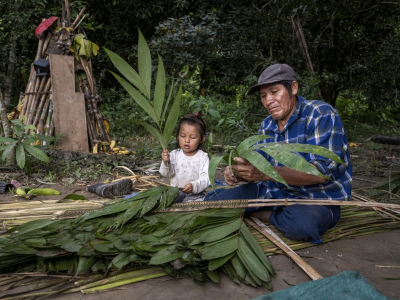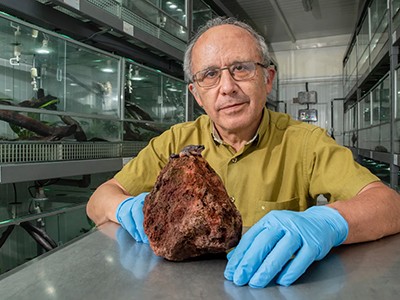As a student in China in the late 1980s, I spent several wonderful semesters studying zoology and botany. I vividly remember the joy of a summer field trip, immersed in taxonomy and biodiversity, where I learnt about a weed called goose-grass. Its well-developed root system makes it difficult to pull out of the soil — earning it the nickname the ‘Dunzhao donkey’, because those attempting to extract it look like exhausted donkeys squatting on the ground.
Taxonomy is crucial for biodiversity conservation — if we can’t properly identify animals, plants and fungi, we can’t find ways to preserve them. But since my student years, working as an ecologist in Shandong, China, I’ve witnessed a decline in the teaching of this important subject. Credit hours for botany and zoology modules have halved at many universities in China. The length of field trips has been reduced owing to lack of funding.
No basis for claim that 80% of biodiversity is found in Indigenous territories
It’s a similar story worldwide. Funding for projects involving taxonomy dropped drastically in the United Kingdom in the 1990s, replaced by those using molecular biology and genetics. Taxonomists in Europe worry that they themselves are becoming an endangered species, with retiring experts often not being replaced. And some low- and middle-income countries (LMICs), including tropical nations that contain some of the world’s biodiversity hotspots, have long faced a shortage of domestic talent.
Decades on, and the costs of these cuts are now apparent. Biodiversity initiatives are struggling to find specialists. For example, in China, hundreds of surveys of animals, plants and fungi are under way, with the aim of improving the conservation of native habitats and species. But many organizers have found it difficult to recruit qualified researchers. Qiao Gexia, an entomologist at the Chinese Academy of Sciences in Beijing, has voiced concern that, as current taxonomists retire, there will be a reduction in studies of important taxa — such as termites, which are crucial to ecosystems but also can damage buildings, roads and bridges, and earwigs, which are useful for pest control but are detrimental to fruit production (see go.nature.com/3msjcxh).
Indeed, a lack of taxonomic knowledge, especially at the local level, is leading to errors. For example, in 2022, a common fish in Xiaoqing River, China, was mistakenly reported to be an endangered species, causing confusion among conservationists and the public.
Harrowing trends: how endangered-species researchers find hope in the dark
If taxonomic knowledge is not maintained, it will become harder to prevent species becoming extinct.
That’s why I feel it’s so important that the Kunming Biodiversity Fund — aimed at supporting global biodiversity conservation — includes a substantial pot of money for biodiversity education. The fund was launched in Beijing in May. Its co-chairs, the Chinese government and the United Nations Environment Programme, hope that the initial investment of 1.5 billion yuan (US$210 million) from China will attract other countries, institutes and organizations to invest in the fund. The money will be used to help LMICs meet the goals of the Kunming–Montreal Global Biodiversity Framework, which has been agreed on by almost 200 countries. The framework sets out 23 targets to be reached by 2030 and 4 goals for 2050, all of which aim to see humans living in harmony with nature.
The first projects to be supported by the Kunming fund are expected to be announced before the start of the COP16 UN biodiversity conference on 21 October, at which progress towards meeting the biodiversity framework targets will be discussed and evaluated. As yet, education has not been mentioned as a focus — but I think it should be.
I would like to see 10% of the Kunming fund’s annual budget put aside for education. It’s crucial to build up taxonomic know-how in LMICs that lack it, and to ensure that it is preserved in those where it might be dwindling.
One priority should be funding programmes in LMICs that teach students taxonomic methods, such as observation of specimens, and modern techniques for assessing the biodiversity of animal and plant communities.
Can floating homes make coastal communities resilient to climate risk?
Laying camera traps and analysing the footage, for instance, is often cheaper, easier and requires fewer people than using live traps does. Analysis of DNA gathered from soil, water or air can be used to accurately assess the species in a local community, without the need to spot them all in the wild. And training in the use of online digital herbaria and collection galleries will enable young scientists to share knowledge and resources across countries.
Universities can support this endeavour by incentivizing biodiversity and taxonomy courses for their students, perhaps by giving them more credits. And they should also offer general courses in taxonomy and biodiversity to students outside the biological sciences, to build awareness.
Some might argue that a focus on direct conservation efforts is the best way for the Kunming fund to help achieve the framework’s 2030 targets. But education is the key to reaching many of those goals, especially because those living in a particular country are the ones best placed to understand its flora and fauna.
Ignoring education will waste the Kunming fund’s resources. There can be no sustainable support for global conservation efforts without generation after generation of properly educated specialists. A lack of expertise will be devastating for the estimated one million species facing extinction worldwide today.
The views expressed are the author’s own and do not necessarily represent those of their institution.





